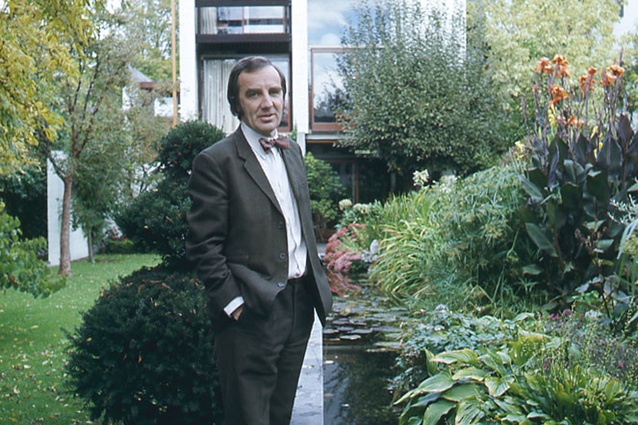Vale: Sir Miles Warren
A mighty tōtara has fallen. Te Kāhui Whaihanga advised yesterday that Sir Miles Warren, one of Aotearoa New Zealand’s most influential and leading architects, has passed away (10 May 1929 – 9 August 2022). He was 93.
Sir Miles’s career spanned decades and will leave a lasting impact on architecture in New Zealand for centuries to come.
“This is an enormous loss of a great architect for New Zealand and the profession. His generosity and support of the profession has been immeasurable,” says Te Kāhui Whaihanga President Judith Taylor.
“I know there will be great sadness across the profession on this news. Our thoughts are with the Warren family, friends and the profession.”
The funeral will be held at Christ’s College Chapel, Christchurch, on Thursday August 18 at 2.00pm.
An outstanding legacy
Born in Christchurch in 1929, Sir Miles Warren began his working life at the age of 16 in the office of Cecil Wood. After initially studying architecture via correspondence at the Christchurch Atelier, he moved to Auckland to complete his studies, then travelled to England in 1953. There he worked with the London County Council and was, in his own words, “extraordinarily fortunate to be sitting right in the middle of the birth of Brutalism.” Influenced by his first-hand experience of the work of Scandinavian architects such as Finn Juhl, Sir Miles returned to New Zealand with a “brimful of ideas” and began designing some of his most iconic buildings.
Sir Miles started his design practice in 1955, beginning with the design of two houses in Timaru that year. In 1956 he designed the Dorset Street flats in Christchurch, and in 1958 he began a long and successful partnership with Maurice Mahoney, winning a large contract to build the Dental Training School. Their practice became known as Warren and Mahoney and the pair’s work is regarded as the birth of the ‘Christchurch School’ of architecture, which melded the solidity of New Brutalism with the lightweight vernacular of the Group Architects.
During the next decade, the practice created buildings such as Christchurch College (now College House), the Harewood Crematorium (awarded an NZIA Gold Medal in 1964), the office and flat at 65 Cambridge Terrace, the Wool Exchange, the Chapman block at Christ’s College and the Canterbury Students Union, all widely regarded as part of the nation’s architectural heritage. But it was winning the high-profile competition for the Christchurch Town Hall (1966-72) that cemented its position among New Zealand’s premier firms.
Commissions in the decade leading up to 1974 included the New Zealand Chancery in Washington, the Civic Offices in Rotorua and the Michael Fowler Centre in Wellington. As Sir Miles himself engagingly remembered the latter commission: “In 1975 I had a telephone call from Mayor Michael Fowler. ‘Hi Miles, would you accept a commission to design our new Wellington Town Hall’. ‘Most certainly,’ says I, ‘what’s the brief’. ‘The same as Christchurch but better’. ‘How long have we got to prepare the sketch plans?’ ‘Six weeks’. Apart from attendant jollities that was about it.”
In 1976 Sir Miles purchased a house at the head of Lyttelton Harbour in partnership with his sister Pauline and her husband John Trengrove for the purpose of creating a large garden together. The house and grounds at Ōhinetahi became a lifelong passion for the keen gardener and remains one of New Zealand’s best formal gardens.
Warren and Mahoney became a multi-textual practice during the building boom of the 1980s, producing a series of design-led office blocks as well as commissions such as Whanganui Collegiate auditorium, St Patrick’s Church in Napier and the Rotorua Civic Centre. The Television New Zealand Network Centre in Auckland was described by Sir Miles as “technically the most complex brief undertaken by the partnership” and marked the end of the excesses of the eighties.
After establishing the F M Warren Scholarship in Art History at the University of Canterbury in 1994, Sir Miles retired in 1995 but remained active as an advocate for architectural education and a patron of the arts. The Warren Trust was established in 2006 and over the last decade has given generously to promote architectural education to both the architectural profession and the wider public in New Zealand. The trust sponsors the Institute’s annual architecture writing awards. In 2012 Sir Miles gifted Ōhinetahi as an endowment to the Ōhinetahi Charitable Trust to ensure it remained open to the public in perpetuity.
Offices and awards
Sir Miles is a Past President of the Canterbury Branch of the New Zealand Institute of Architects, was a Member of the Council of the Institute, and Chairman of the Education and Registration Authority. Sir Miles was made a Fellow of the New Zealand Institute of Architects in 1965, awarded the NZIA Award of Honour in 1987 and the NZIA Gold Medal in 2000. Warren & Mahoney won NZIA Gold Medals (now New Zealand Architecture Awards) in 1959, 1964, 1969 and 1973.
Other awards and distinctions
Sir Miles was made a CBE in 1974, knighted in 1985 and was awarded the Order of New Zealand in 1995. In 2001 he received an Honorary Doctorate from the University of Auckland, and in 2003 he received an Icon Award from the Arts Foundation of New Zealand. He was an active Member of a number of other professional and artistic organisations, including the Canterbury Society of Arts and the Theatre Royal Christchurch Charitable Management Committee.
First published by the New Zealand Institute of Architects on 10 August 2022.










